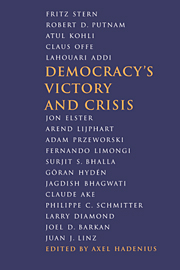Book contents
- Frontmatter
- Contents
- List of contributors
- Acknowledgments
- 1 Victory and crisis: introduction
- Part 1 Historical perspectives
- Part 2 Social and cultural aspects
- Part 3 Constitutional questions
- Part 4 Democracy and development
- Part 5 Democracy and globalization
- Part 6 Promoting democracy
- 15 Promoting democracy in the 1990s: actors, instruments, and issues
- 16 Can established democracies nurture democracy abroad? Lessons from Africa
- 17 Some thoughts on the victory and future of democracy
- Index
15 - Promoting democracy in the 1990s: actors, instruments, and issues
Published online by Cambridge University Press: 13 October 2009
- Frontmatter
- Contents
- List of contributors
- Acknowledgments
- 1 Victory and crisis: introduction
- Part 1 Historical perspectives
- Part 2 Social and cultural aspects
- Part 3 Constitutional questions
- Part 4 Democracy and development
- Part 5 Democracy and globalization
- Part 6 Promoting democracy
- 15 Promoting democracy in the 1990s: actors, instruments, and issues
- 16 Can established democracies nurture democracy abroad? Lessons from Africa
- 17 Some thoughts on the victory and future of democracy
- Index
Summary
Since 1974, a “third wave” of global democratization has dramatically increased the number of democracies. If we choose as our operational standard of democracy the presence of a civilian, constitutional, multiparty regime, with competitive elections, one could count as many as 114 “democracies” in the world at the end of 1994 (Karatnycky 1995: 5). This is almost twice the number of formal democracies in 1984. If, however, we insist on looking beyond constitutional form and even electoral conduct, and consider as well real levels of political freedom and civil liberties, a different picture emerges. In its annual survey of freedom in the world for 1994, Freedom House counted seventy-six countries as “free.” This is a substantial increase from forty-two in 1972, and fifty-three in 1985. Yet, by this calculus, a third of the formal democracies in the world (thirty-eight) do not rate as “free” because the power of democratically elected leaders is seriously constrained by unaccountable groups, particularly the military (as in Pakistan, Turkey, and Guatemala); or because political and ethnic violence mar individual freedom and the integrity of political competition (as in India, Colombia, and El Salvador); or because the actual performance and accountability of formal democratic institutions pushes the quality of political competition, representation, organization, and/or expression below a critical threshold (as in Venezuela, the Philippines, and Zambia, in the judgment of Freedom House). Clearly, there is a large gap between democratic form and reality in the world, and this bears serious implications for the challenge of democratic consolidation, which, I argue, must be the ultimate goal of international efforts to promote democracy.
I use the term “democracy” as roughly equivalent to Dahl's “polyarchy,” or “liberal democracy.”
- Type
- Chapter
- Information
- Democracy's Victory and Crisis , pp. 311 - 370Publisher: Cambridge University PressPrint publication year: 1997
- 10
- Cited by



